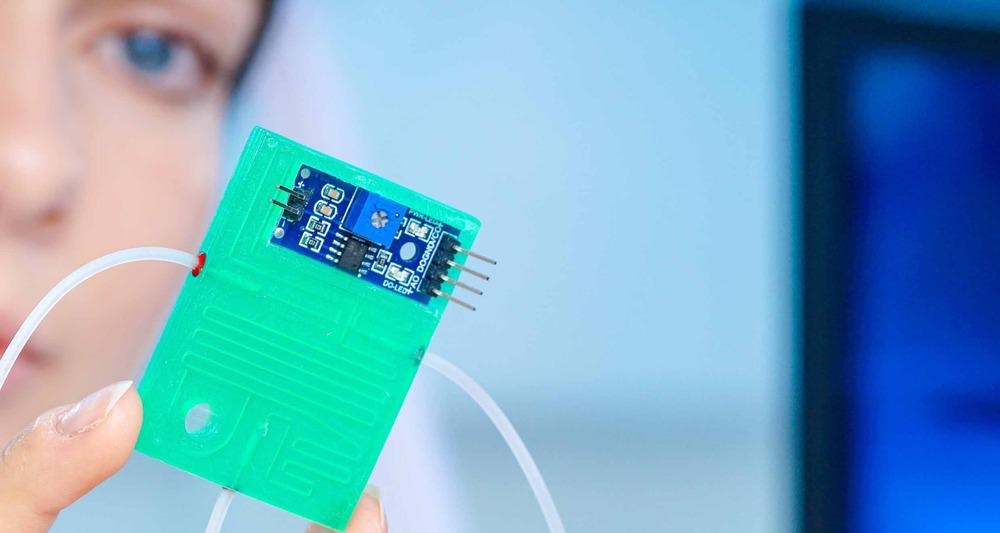A new carbon-based semiconducting material could be key to building the next cohort of biosensors designed to monitor individual health. The material outclasses existing options, but developing such a component was not without its challenges.

Image Credit: luchschenF/Shutterstock.com
An international team of researchers, led by researchers from King Abdullah University of Science and Technology (KAUST) in Saudi Arabia, were able to overcome these critical issues to develop a functional material for next-generation devices.
Biosensors for Health
Biosensors are cost-effective and easy-to-use devices utilized in several applications, ranging from food packaging to agriculture and environmental monitoring. Every biosensor consists of a biological component that acts as the sensor and an electronic section that detects and transmits the signal.
Biosensors are sensitive and highly accurate, which makes them ideal for health monitoring, and there is significant interest in novel biosensors that directly interact with the body to detect key biochemicals. The biochemicals can provide clues to a person’s health, and biosensors can be used in general healthcare monitoring, screening for disease, and for clinical analysis and diagnosis of disease.
However, it can be difficult to reconcile the technical requirements of these analytical devices with the biocompatible needs. “For a sensor to be compatible with the body, we need to use soft organic materials with mechanical properties that match those of biological tissues,” says Rawad Hallani, a former research scientist at KAUST.
Many research teams have tried and failed to develop a material that resolves the two, but the KAUST team, which included researchers from Northwestern University in the USA and the University of Oxford in the UK are the first to develop a specific polymer that does just this.
The KAUST Material
The team designed a polymer for use in organic electrochemical transistors (OECTs). In these devices, the polymer should allow specific ions and biochemical compounds to permeate into the polymer and ‘dope’ it. This controls its electrochemical semiconducting properties.
“The fluctuation in the electrochemical properties is what we are actually measuring as an output signal of the OECT,” explains Hallani, whose research focuses on synthesizing organic electronic materials that can be used in different electronic and optoelectronic applications.
The team had to overcome various chemical challenges as even the smallest change in the polymer structure can significantly affect the performance. Its material is based on polymers called polythiophene, specifically pgBTTT (biothiophene-co-thierothiophene). These polymers contain a chemical group known as glycols attached in a precisely controlled position, namely the 4,4’ position.
A key element of this breakthrough was understanding how to control the location of the glycol group. These groups are an efficient means of increasing the bulk electrochemical doping and optimizing aqueous swelling. The team achieved this with sophisticated computational chemistry modelling.
“Identifying the right polymer design to fit all the criteria that you are looking for is the tough part,” explains Hallani. “Sometimes what can optimize the performance of the material can negatively affect its stability, so we need to keep in mind the energetic as well as the electronic properties of the polymer.”
Analysis Techniques
Specialized X-ray scattering analysis and scanning tunneling electron microscopy was used to monitor the structure of the polymer. These demonstrated how the position of the glycol group can affect the microstructure and electronic properties of the material.
We are excited by the progress Rawad made on the polymer synthesis, and we are now looking forward to testing our new polymer in specific biosensor devices,”
Iain McCulloch, University of Oxford
The team is now aiming to improve the stability of its polymers and the sensors built from them as they transition from laboratory demonstrations towards real-world applications.
References and Further Reading
Kaust Discovery (2021) Building a better biosensor polymer, Kaust Discovery - https://discovery.kaust.edu.sa/en/article/1148/building-a-better-biosensor-polymer. Accessed 6th July 2021.
Hallani, R. et al (2021) Regiochemistry-Driven Organic Electrochemical Transistor Performance Enhancement in Ethylene Glycol-Functionalized Polythiophenes – Journal of the American Chemical Society - https://pubs.acs.org/doi/10.1021/jacs.1c03516. Accessed 6th July 2021.
Disclaimer: The views expressed here are those of the author expressed in their private capacity and do not necessarily represent the views of AZoM.com Limited T/A AZoNetwork the owner and operator of this website. This disclaimer forms part of the Terms and conditions of use of this website.